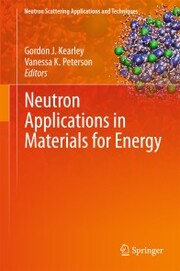Detailansicht
Neutron Applications in Materials for Energy
eBook - Neutron Scattering Applications and Techniques
ISBN/EAN: 9783319066561
Umbreit-Nr.: 9281531
Sprache:
Englisch
Umfang: 0 S., 12.91 MB
Format in cm:
Einband:
Keine Angabe
Erschienen am 23.01.2015
Auflage: 1/2015
E-Book
Format: PDF
DRM: Digitales Wasserzeichen
- Zusatztext
- <p><i>Neutron Applications in Materials for Energy</i>collects results and conclusions of recent neutron-based investigations of materials that are important in the development of sustainable energy.&nbsp;Chapters are authored by leading scientists with hands-on experience in the field, providing overviews, recent highlights, and case-studies to illustrate the applicability of one or more neutron-based techniques of analysis. The theme follows energy production, storage, and use, but each chapter, or section, can also be read independently, with basic theory and instrumentation for neutron scattering being outlined in the introductory chapter.</p><p>Whilst neutron scattering is extensively used to understand properties of condensed matter, neutron techniques are exceptionally-well suited to studying how the transport and binding of energy and charge-carrying molecules and ions are related to their dynamics and the materials crystal structure. These studies extend to<i>in situ</i> and<i>in operando</i> in some cases. The species of interest in leading energy-technologies include H<sub>2</sub>, H<sup>+</sup>, and Li<sup>+</sup> which have particularly favourable neutron-scattering properties that render these techniques of analysis ideal for such studies and consequently, neutron-based analysis is common-place for hydrogen storage, fuel-cell, catalysis, and battery materials. Similar research into the functionality of solar cell, nuclear, and CO<sub>2</sub> capture/storage materials rely on other unique aspects of neutron scattering and again show how structure and dynamics provide an understanding of the material stability and the binding and mobility of species of interest within these materials.</p><p>&nbsp;Scientists and students looking for methods to help them understand the atomic-level mechanisms and behaviour underpinning the performance characteristics of energy materials will find<i>Neutron Applications in Materials for Energy</i>a valuable resource,whilst the wider audience of sustainable energy scientists, and newcomers to neutron scattering should find this a useful reference.</p>
- Autorenportrait
- Prof Don Kearley received his PhD from the University of East Anglia, UK, worked at the Institut Laue-Langevin in Grenoble, France, became Chair of Radiation Physics at Delft University of Technology, the Netherlands, and is presently Senior Researcher in the Neutron Scattering Group at the Bragg Institute of ANSTO (Australian Nuclear Science and Technology Organization). He has a fair experience of most neutron-scattering techniques, particularly inelastic and quasielastic methods. Currently most of his work is in providing modelling support for the neutron scattering activities of scientists at the Bragg institute and elsewhere, which is usually in the form of understanding the underlying mechanism in function. Dr Vanessa Peterson is a Senior Research and Instrument Scientist at ANSTO (Australian Nuclear Science and Technology Organization). Her expertise includes structure and dynamics in chemistry and their relationship to properties in condensed matter materials including cement,porous coordination framework materials, and hydrogen storage materials. She has also great expertise in analyses techniques like Synchrotron/Laboratory X-Ray and Neutron Powder Diffraction, Rietveld analysis, Quasi-Elastic Neutron Scattering, Inelastic Neutron Scattering, and Single Crystal X-Ray Diffraction.
